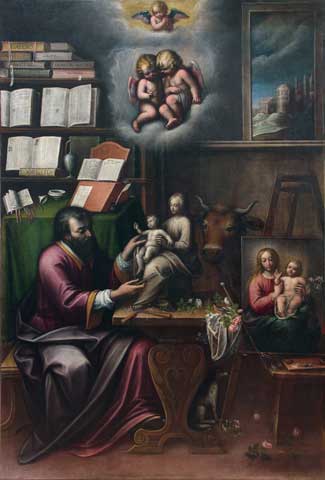
Orsola Maddalena Caccia, "St. Luke the Evangelist in the Studio" (circa 1625), Parrocchia Sant'Antonio di Padova, Moncalvo, Asti (Art courtesy of the National Museum of Women in the Arts)
One of the best places to learn about the tools and techniques that medieval artists employed to create illuminated manuscripts is their depictions of saints writing and illustrating sacred texts. In art, when St. Luke represents the Virgin, he typically clutches a paintbrush or quill in his hand, and he often stands or sits at a lectern. Sometimes, he holds a knife, which was used for scraping out errors, sharpening pens, or a variety of other tasks. That's why Orsola Maddalena Caccia's circa 1625 painting "St. Luke the Evangelist in the Studio" is so unusual.
Her altarpiece painting confronts visitors immediately upon entering the exhibit "Picturing Mary: Woman, Mother, Idea," on view at the National Museum of Women in the Arts in Washington through April 12. The Italian nun depicts the saint as a sculptor mid-study. Clad in magenta and black robes, Luke sits at a table with books and an unfinished manuscript behind him. An ox, his emblem, lurks behind the table, and a beautiful seascape is visible out a window in the top right corner of the painting. Directly beneath the window, a finished or nearly complete canvas hangs on an easel.
That Caccia made Luke a sculptor is rare, and that he is both a sculptor and a painter is "highly unusual" or even unprecedented, exhibit curator Msgr. Timothy Verdon wrote in his catalog essay for the exhibit.
Verdon, director of the Museo dell'Opera del Duomo in Florence, Italy, sees not only aesthetic significance in Luke-as-sculptor -- fierce debate used to surround the question of whether painting or sculpture was the superior art form -- but also theological significance. Luke's open book in the background, Verdon wrote, suggests that the saint has temporarily interrupted his writings to make art.
"Caccia, the Catholic nun, probably wanted to respond to Protestant Christians who assert that 'only Scripture' counts, and she did so by suggesting that writers, even evangelists, work from mental images, and that sacred 'picturing' was actually a part of the very process that produced the inspired texts," Verdon wrote. "It is clear that when [St. Luke] resumes writing his Gospel, he will incorporate the ideas developed in painting and carving Christ and his mother."
The Caccia painting is one of about 70 works in the exhibit, which include standout pieces by Luca della Robbia, Fra Filippo Lippi, Sandro Botticelli, Albrecht Dürer, Titian, Caravaggio, and Rembrandt. Lorenzo di Credi's "Annunciation" (from Florence's Uffizi Gallery), which portrays Gabriel's appearance to Mary in a beautifully rendered interior space, set above three panels with Genesis stories -- the creation of man, the temptation, and the expulsion from Eden -- is noteworthy both for its religious symbolic program and for its aesthetic composition.
The juxtaposition of Mary receiving the news and the displacement of the first couple from paradise isn't new. A 1507 woodcut at Boston's Museum of Fine Arts by an unidentified artist, and Giovanni di Paolo's circa 1435 "Annunciation and Expulsion from Paradise" at Washington's National Gallery of Art, for example, both draw the same comparison.
Di Credi "in effect illustrates the Christian anthropological notion that, just as Christ is a new Adam ... so Mary is a new and better Eve," Verdon wrote. "Theologians have pointed out that whereas Eve's 'no' to God brought death into the world, Mary's 'yes' brought Christ, who is life."
That claim is amplified by a vague allusion between Mary's hand gesture in di Credi's painting and that of Eve below, reaching for the fruit of the Tree of Knowledge.
However fine some of the examples of works are in the exhibit -- which the museum's ad campaigns focus on as a chance to "Meet Mary" -- some of the contours of the meetings that the exhibit is brokering between Mary and the public are drawing criticism, as from The Washington Post's Philip Kennicott.
Although Kennicott wrote that if the exhibit can't fill the museum's galleries with visitor "throngs" nothing will, he also cited two "serious problems" with the exhibit: its "arbitrarily" ending in the 19th century, and its ignoring of the "darker side of Marian imagery."
Kennicott doesn't say it, but one gets the sense that just as the major 1996 exhibit at New York's Jewish Museum explored what "too Jewish" might mean, this show might strike some visitors as "too Catholic."
"How can a museum that wants to be taken seriously as a site for contemporary art ignore works such as Chris Ofili's 'The Holy Virgin Mary?' " Kennicott wrote. "Easy. It wanted a feel-good show." (That work, which was part of the notorious "Sensation" exhibit in New York in 1999, includes elephant dung among its materials.)
Living in what he describes as "a monolithic Roman Catholic country," Verdon said it's hard for him to grasp "U.S. hypersensibility" on what he didn't include in the exhibit.
"It's obvious that an exhibit on Mary in art is going to be strongly Catholic in character," he said. "If people have problems with 70 works of art that recount one of the West's great cultural motors -- Catholic faith -- they can just not go to the show. On this side of the ocean, a lot of walls have fallen, and we're all willing to look at what others consider important."
The divide across the pond, so to speak, is partially consistent with what Paul Griffiths, Warren Professor of Catholic Theology at Duke Divinity School, has observed.
"Catholicism in the United States is a little more ideologically divided than most European Catholicism. What tends to happen here [in the U.S.] is that almost anything that one does as a Catholic is triangulated into 'It's a Conservative position,' or 'It's a liberal position,' " he said. "I think that's less true in much of Europe. That would affect how representations of Mary are thought about as well."
Given the "black Madonna" tradition in medieval Europe and the resemblance between South Indian Marian imagery and depictions of Hindu deities, it's tough to delineate clean divisions, according to Griffiths.
"There's a porous or open boundary between what we might think of as normative, orthodox Catholicism on the one hand, and broad, popular piety on the other," he said. "And they feed back into one another, and they flow back out of one another. It's not a rigid, sharp, bright line."
Matthew Milliner, assistant professor of art history at Wheaton College in Illinois, teaches a course on "Image and Ideas of the Virgin Mary." He noted that Mary is also important to non-Christians and that a prominent Chicago mosque is named Mosque Maryam.
"Of course, there are many perspectives on Mary," Milliner said, "but Christian perspectives on Mary tend to dwarf other views."
Milliner, who hasn't yet seen the exhibit, said he hopes it considers the recently translated The Life of the Virgin (the catalog doesn't mention that work, although it footnotes an earlier work by the translator, Stephen J. Shoemaker) and "exciting postsecular feminist perspectives on Mary from daring scholars like Tina Beattie" (she doesn't appear in the catalog).
"The extraordinary Marian tradition single-handedly disproves the outdated assertion that Christianity is inhospitable to women," Milliner said. "Even Protestants have come around to celebrating Mary, and I would not be surprised if many others hoped to celebrate her as well."
Griffiths also mentioned the thinking feminist theologians have done about the idealization of Mary in the Catholic church.
"For many Catholics, Mary feels more accessible, more intimately available than Jesus does, and that's why there's always been such a deep and flourishing quality about Mary. People talk to her, light candles to her, celebrate her in various ways," he said. "Mary feels available."
[Menachem Wecker is the former education reporter at U.S. News & World Report. His book, Consider No Evil: Two Faith Traditions and the Problem of Academic Freedom in Religious Higher Education, co-authored with Brandon Withrow, was published this summer by Cascade Books.]




